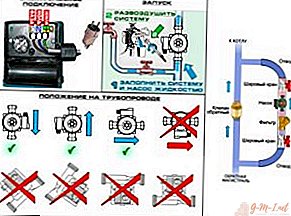Of course, before installation, it is necessary to determine the zone in which the actions will take place. Connecting the pump to the heating boiler requires some knowledge.It is recommended to install after the boiler, i.e. before the first branch.
Choosing a place to insert the device into the system
If the house already has two branches (for example, on different floors), then you should put two devices - each separately. And also after the boiler. If one will go up, then the fuel will be consumed much less, since the coolant will move less. Do not worry about damage to your stay, as it is completely safe.

REFERENCE! Thanks to modern technologies and materials used in the manufacture, the device calmly withstands even the highest temperatures and is not afraid of water. Therefore, it can be installed both on the return pipe and on the supply pipe.
There are features that you should consider:
- There should be no leakage origin over the chosen location.
- It must be provided with accessibility so that, if necessary, it is possible to perform maintenance, preventive maintenance for equipment or repair it.
- In addition to access for you, it should be for the mains.
- The pump is positioned in the direction of movement of the coolant.
Installing a circulation pump in the heating circuit
In principle, the device works perfectly everywhere, regardless of part of the heating circuit. But it is worth remembering the following when connecting to the boiler:
- The position of the resource of bearings determines the temperature of the carrier, that is - the lower the indicator of the first of them, the greater it is in the second.
- The tank, in turn, is desirable to be mounted so that it is close enough to the laminar flow.
Basic rules for installing a circulation pump
 The filter must crash, as this protects the apparatus from foreign particles.
The filter must crash, as this protects the apparatus from foreign particles.- Carry out some steps to ground the outlet into which the device will be connected. This should be done for your own safety.
- To avoid leaks, use sealant for threaded connections.
- At installation watch an arrow. She moves for the direction of the coolant.
- Give fixation to ball valves that are on the sides of the structure.
- In order to increase the potential of work, it is necessary to perform the processing of all fasteners. In a fatal outcome, the surface of the unit is threatened with various damages, and the whole process will appear meaningless.
- Follow the connection sequence.
- At the top of the bypass there must be air valves that discharge air from the system.
How to install a pump for a heating system yourself
Once the location has already been selected, you can proceed to the installation of the device. First, the heat carrier should be drained if the installation will take place in an existing network. With long-term operation, it is necessary to clean from possible blockages. To do this, run water several times through it.
 Installation needs to be reproduced in the place of cutting. This is carried out in accordance with the heating scheme. After that, you need to connect the pump to the heating system - fill it with heating, water. Check the performance, because it is better to detect defects at this stage, if they are, fix it. The next step is to remove excess air by opening the central screw that appears on the housing cover. With the right outcome, you will notice water, this will mean that the air mass is eliminated, that is, the fidelity of your actions.
Installation needs to be reproduced in the place of cutting. This is carried out in accordance with the heating scheme. After that, you need to connect the pump to the heating system - fill it with heating, water. Check the performance, because it is better to detect defects at this stage, if they are, fix it. The next step is to remove excess air by opening the central screw that appears on the housing cover. With the right outcome, you will notice water, this will mean that the air mass is eliminated, that is, the fidelity of your actions.
ATTENTION! To ensure long-term operation of the unit, you can purchase an automatic pump.
Network connection
It is such a pump that needs to be connected both to a differential automaton and to a thermostat. There are also two more ways: connecting at the same time with an uninterruptible power supply unit, and using the boiler automation.
- As for the scheme of the first of them, this is the most optimal option, it is very simple and easy to use. It will be necessary to have only wires, a differential switch (8A) and contacts. First of all, you need to cut the cable of the desired length and stretch it through the corrugation. Together they are routed through the shield to the pump. The cable is connected using a phase wire (to L), and to N - zero. It remains to connect the ground to the PE terminal.
- In order to automatically stop the movement at low temperature, a circulation pump with a thermostat is used. When cooling comes, the power circuit breaks. For this to happen, you need to attach the thermostat to the pipeline. Also, it is best to connect it to the metal section of the highway so that it provides reliable information.


 The filter must crash, as this protects the apparatus from foreign particles.
The filter must crash, as this protects the apparatus from foreign particles.
Leave Your Comment